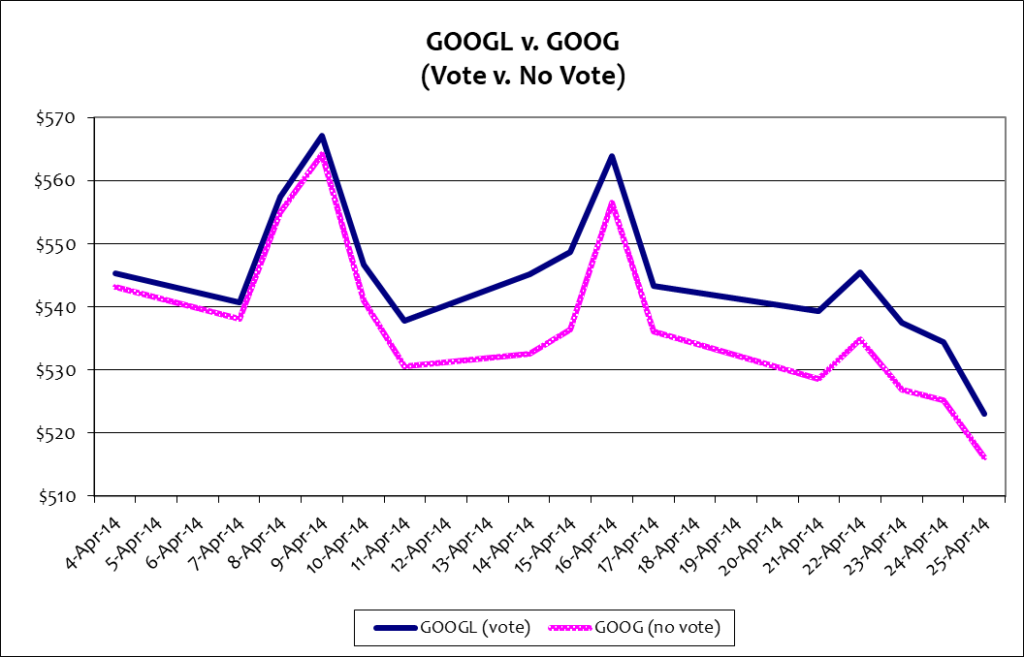Two companies have recently made drastic changes to their corporate identities via stock splits. On April 3, 2014, Google issued its first stock split, a 2 for 1 affair that saw the creation of a new class of stock and symbol. Google will now trade under two symbols: GOOG and GOOGL, both around $525 dollars per share. Before the split Google’s share price was over $1,000 – but even at half the post-split price, it’s still a high priced stock. And there’s a message in that.
Google has been on an investment tare for quite a while. Like many companies, Google uses its stock as cash to invest, acquire new businesses, and compensate employees. As a result, equity positions for the founding members (Larry Page and Sergey Brin) got diluted every time a transaction like those took place. So to avoid losing control of their company, and while continuing to aggressively pursue and invest in growth opportunities, Page and Brin created a new class of stock (which will be traded under the original symbol GOOG) that will have no voting rights. Needless to say, new acquisitions and investments will be financed with GOOG stock, thus maintaining the sanctity and stability of ownership under the GOOGL symbol.
Here’s how the two Google symbols performed since the split.

As you can see, stock with voting rights has more value than non-voting shares do. This is generally true with all companies. But the point to take away is this: Google made its stock split decision solely to maintain corporate ownership control by founding members, Page and Brin. The slim 2 for 1 split was a tactic employed to do simply that.
This is much to the contrary of Apple’s decision to split. Just a few days ago on April 24, 2014, Apple made a startling announcement of a 7 to 1 stock-split to become effective on June 9, 2014. There will be no new class of share issued, which is to say that maintaining current ownership control had absolutely nothing to do with Apple’s decision.
Instead, the decision was made to “make Apple stock more accessible to a larger number of investors.” In other words, their stock split decision was made primarily to increase demand for Apple stock, to thus raise the share price and produce a more robust return on investment to investors than otherwise would be had.
Apple’s stock climbed $43 to $567 per share, or 8%, on the announcement. News of the stock split was accompanied by a commitment to increase Apple’s dividend and stock buyback program. Positive earnings were also reported – all of which contributed to the upward move. If Apple stock were to split today its share price would be around $80 per share.
The 7 to 1 split ratio is an interesting rate of change. Late last year MasterCard executed a 10 to 1 stock split that also brought its per share price down to $80 – about half the price of Visa, the most widely used card. A 10 to 1 split would make Apple stock even more accessible (around $55 per share) and, in theory, would create even more investor demand.
But creating demand wasn’t the only factor in Apple’s stock-split decision.
It is quite clear that Tim Cook doesn’t want Apple’s stock price to be anywhere near Google’s – they are two different companies, in two different modes. Cook wanted no part of an Apple–Google comparison. They’re too different.
Instead, Apple took a page from MasterCard’s book and split to a ratio placing it properly to their nearest competitor. Microsoft, which is now trading around $40 per share, is half the amount Apple will be trading post-split. That’s where Tim Cook places Apple in the technology food-chain.
There is little doubt that Tim Cook doesn’t want to be the next Steve Ballmer (Bill Gates’ successor). Ballmer failed to innovate or successfully invest during his tenure at Microsoft’s helm, and investor ROI was pathetic – especially when considering Microsoft’s obnoxious cash balance and net worth during the time. Cook won’t make that same mistake. Aggressive stock buybacks, increased dividends, and a lower stock price are tactics employed to combat that specific case.
Decision points like IPO’s and stock splits send important positioning messages from management. It is the only place corporations can provide a starting price for its stock to trade. Free markets, of course, determine value once trading commences.
That said, logic can only surmise that Cook is positioning Apple for pedestrian operating growth to be offset by strong stock performance via higher dividends and stock buybacks, and hopefully new demand driven by a lower priced stock.
Google, on the other hand, is positioning itself to continue aggressively investing in future growth under the same ownership structure, while maintaining a premium image with a double dose of higher priced stocks.
Google has sent the stronger message; and is a component of the 15-51 strength indicator.

The market message remains the same: stocks are high, strength is higher, and gold is about fair.
Stay tuned…

